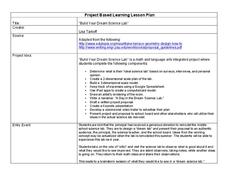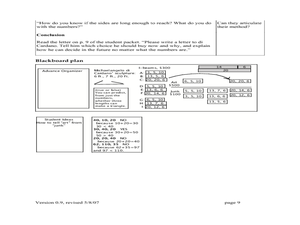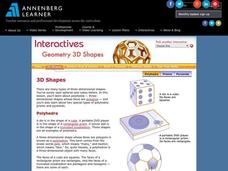Curated OER
Animals in Art
Second graders demonstrate visual awareness by listing seven to nine types of animals shown in the artwork on the tour. They draw three types of textured lines or patterns shown in the tour artwork and model an imaginary animal using clay.
Curated OER
Painting Modern Life
Examine three Cubism art pieces by Pablo Picasso and Georges Braque with your students. They will research how Cubism was advanced due to Picasso and Braque. and then compare and contrast Cubist works through image based discussion. Your...
Curated OER
Making Twisteez Masks
Young artists build a three-dimensional form with Twisteez Wire on a stationary screen base. They can paint the base if they wish. The results of this art project are spectacular, but be warned that the materials needed are not easy to...
Curated OER
Exploring Optical Movement in Art
Young scholars describe, represent and analyze patterns and relationships using shapes. They create simple geometric patterns. They demonstrate increasing technical ability and skill to complete visual arts assignments.
Curated OER
Soft Sculpture Birds
Art can mimic life, and animals are always interesting subjects. Learners create large soft sculptures (stuffed) birds using paper, paint, and other basic collage materials. They view images of birds, and discuss bird traits and shapes....
Curated OER
Build Your Dream Science Lab
Would your ideal science lab be filled with bubbling beakers and zapping Tesla coils? Or would it contain state-of-the-art computer technology and data analysis? Dream big with an innovative lesson that connects math and language...
Dick Blick Art Materials
EZ-Grout Mosaics
Young artists create 2-D art using air-dry clay and acrylic paint in this mosaic-making activity. Kids trace their design sketch on a clay slab, cut out the pieces, and after drying, paint and mount their tile design.
Illustrative Mathematics
Christo’s Building
Hook your charges on how to solve a real-world art problem with mathematics by showing works of Christo. You can find eye-catching images on the Christo and Jeanne Claude webpage. Here, math learners help Jean Claude and Christo prepare...
Curated OER
Lesson Plan: A Miniature Game
Art inspires art, as children work to understand artistic forms that come from the imagination. They analyze the installation piece, Fox Games and then discuss the design process. They then use clay to create imaginative dioramas,...
Curated OER
Tin-Foil Twinkles
Learners compare and discuss characteristics and properties of 2- and 3-dimensional shapes. They construct 3-dimensional paper star figures, imaginatively customizing them with art tools and craft materials. Students analyze their...
Curated OER
3-D Multicultural Ornaments
Students create and color three-dimensional ornaments reflecting December's many cultural celebrations. They decide which symbol they wish to create as an ornament, draw or trace the outline of the symbol, and follow directions as they...
Curated OER
Art or Junk? Discovering the Triangle Inequality
Middle schoolers study the triangle inequality. They will identify, compare, and analyze attributes of two and three-dimensional shapes. Then they develop vocabulary to describe the attributes. They also use manipulatives to analyze the...
K12 Reader
3-D: It’s Not Just for Movies
This two-part reading comprehension exercise asks kids to read a short passage about cubes, rectangular prisms, spheres and pyramids, and then to respond to a series of questions about the article.
Curated OER
Flexible "Glass" Sculpture
Older artists create 2-dimensional surfaces with paint, then use these paintings as the components of a 3-dimensional sculpture. They assemble a free-standing sculpture that may be viewed from any angle by using wire to create the shape....
National Gallery of Canada
My World
Art can tell viewers about an artist's personality and background. Have your learners look at Inuit art and consider subject matter and how it relates to the artist and his or her world. The related art project requires pupils to create...
Curated OER
Expressing Emotions Through Art Lesson 4: Everybody Celebrates
Students examine how feelings of caring and working together can be expressed in works of art, and define the terms two-dimensional and three-dimensional. They design and create celebratory hats using three-dimensional paper techniques.
Curated OER
Expressing Emotions Through Art Lesson 3: Everybody Works Together
Students examine works of art that convey the idea of working together and analyze how artists use foreground, middle ground, and background. They use two-and three-dimensional materials to create a work of art.
Curated OER
Sculptural Heads
High schoolers create sculptures of a human head with Sculptamold. They discover the differences between two and three dimensional art. They combine art history, aestetics and personal expression to create a sculpture.
Curated OER
Finding Polygons in Cubist Art
Fourth graders explore geometric properties and relationships in a two-dimensional work of art. They first search for and identify polygons in a Cubist painting and then use polygons to create their own Cubist portrait of a classmate.
Curated OER
Balance in Visual Art
Students examine works of art to develop an understanding of the importance of visual balance in works of art and nature. Students research artists and their artwork for examples of visual balance. Students create works of art showing...
Annenberg Foundation
Geometry 3D Shapes: 3D Shapes
Explore vocabulary related to three-dimensional shapes. An instructional website describes the characteristics of different geometric solids. Learners can use an interactive component to view nets, faces, vertices, and edges of common...
Annenberg Foundation
Geometry 3D Shapes: Platonic Solids
From polyhedrons to platonic solids, here is a lesson that will have your classes talking! As an introduction to platonic solids, scholars cut and fold nets to create the three-dimensional solids. They use an interactive component to...
Annenberg Foundation
Geometry 3D Shapes: Euler's Theorem
How do you get a theorem named after you? Euler knows what it takes! The third lesson of five asks pupils to use an interactive activity to compare the faces, vertices, and edges of seven different three-dimensional solids. They use...
Curated OER
Fantastic Journeys
Students design an amusement park attraction based on a fantastic journey from literature, film, or their own imaginations. Each design team must submit a formal proposal. The proposal should include: a two- or three-dimensional visual...
Other popular searches
- Three Dimensional Art
- 3 Dimensional Art Shapes
- Teaching 3 Dimensional Art
- 3 Dimensional Art Craft
- Three Dimensional Art























